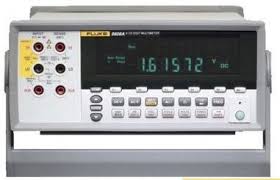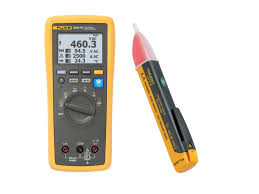Basic information and explanation of how digital multimeters differ from analog testers
Overview
To check the status of electronic devices, measuring instruments are required. Because such information is not visible, digital multimeters are advised for checking the state of an electrical item. This article addresses questions regarding digital multimeters that you might be ashamed to ask (for example, what are digital multimeters and how do they vary from analog testers), provides an overview of the many varieties, and explains how to pick the correct model for you.
Even for beginners, this digital multimeter is simple to operate.
What are digital Multimeters?
Digital multimeters are measuring tools that can measure voltage, current, and resistance among other things. Measured data are shown on a digital display, making them accessible to even inexperienced users.
Some digital multimeters choose the measurement range for you automatically, so you don't have to. As a result, even for beginners, these instruments are rather simple to operate. Analog testers, of course, have their advantages, such as the simplicity with which changes in the measured value can be read during measurement and the intuitive ease with which a needle can be examined in places where a digital reading could be difficult to see.
Because both digital multimeters and analog testers offer benefits, you can choose which instrument is ideal for your application by defining what you want to measure.
-

Fluke 8808A 240V 5.5 Digital multimeter
High-precision digital multimeters
Although digital multimeters are frequently described as having great precision, the precision of measurement findings is not significantly different from that of analog testers. However, "high precision" in this sense refers to the instruments' capacity to handle greater resolutions due to their digital displays' ability to display more digits. Because analog testers use a needle to show values, it's possible that the individual operating the instrument will make a reading error. Reading errors are the term for such mistakes.
When measuring a phenomenon that’s characterized by a high level of variability, the value of the minimum digit on digital instruments can change quickly, making the result difficult to read. In such situations, it may be easier to read the result as an average value on an analog tester since the needle is incapable of mechanically tracking the fluctuations.
Types of digital multimeters
Digital multimeters can be broadly classified as either of two types.
Handheld type

Benchtop type

Fluke 8808A 220V 5.5 Digital multimeter
Handheld digital multimeter models feature a compact design so that they can be held during use. Since they are easy to carry, they can be used in a variety of applications, from laboratories to on-site work. Just because they're compact doesn’t mean they lack for functionality. High-end models are available, so you can choose the instrument that’s right for your application. Handheld models are available in a variety of form factors, including compact, card-shaped, and pen-shaped varieties.
What to Look for When Buying a Digital Multimeter
The wide range of functionality offered by digital multimeters may confuse many first-time buyers. How would one pick the ideal instrument for a certain task? The first step is to see if a potential model has the required functionality and to examine characteristics such as range and resolution. If you want to use the instrument outdoors, such as at a construction site, select a model that is built to withstand such conditions.
If you’ll need to take the instrument with you frequently, a large model would presumably be difficult to use. Compact products encompass a broad range of variants, from simple, card-shaped models to functional handheld designs, so carefully considering the environment in which you’ll use the instrument is a good way to gain peace of mind. It’s also important to choose a digital multimeter with the right level of precision for the application.
Multifunctional digital multimeters have the advantage of being usable in an array of situations. Of course, if you’ll mostly be using the instrument in circumstances that don’t require much precision, there’s no need to choose an expensive model. Try to choose a model with the precision and functionality that you need.
Finally, it’s also important to choose a digital multimeter that will ensure safety at the worksite.Choosing the right digital multimeter for you
Digital multimeters display values in an easily readable format, and there’s a trend toward multifunctional models with high precision and resolution. Since there are so many types available, it's not unusual for purchasers to become confused about which model best suits their needs. When choosing a digital multimeter, the first step is to ask what functions you wish to use.
Then consider factors such as safety and the operating environment and you’ll be able to choose the digital multimeter that best meets your needs.We have all digital Multimeters in stock now. Click Here to fill out our form and request a quote for any of our available multimeters.



